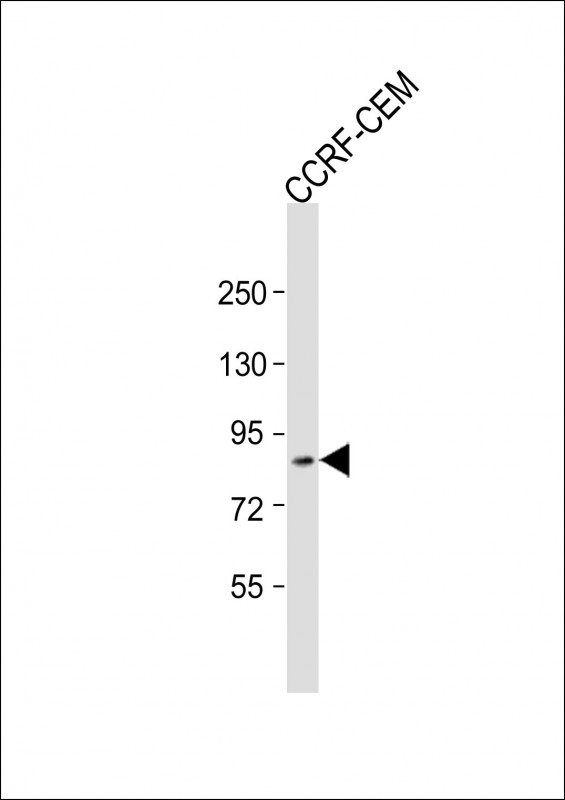
| WB | 1/2000 | Human,Mouse,Rat |
| IF | 咨询技术 | Human,Mouse,Rat |
| IHC | 咨询技术 | Human,Mouse,Rat |
| ICC | 技术咨询 | Human,Mouse,Rat |
| FCM | 咨询技术 | Human,Mouse,Rat |
| Elisa | 咨询技术 | Human,Mouse,Rat |
| Aliases | Zinc finger protein with KRAB and SCAN domains 5, Zinc finger protein 95 homolog, Zfp-95, ZKSCAN5, KIAA1015, ZFP95 |
| Entrez GeneID | 23660 |
| WB Predicted band size | 96.9kDa |
| Host/Isotype | Rabbit IgG |
| Antibody Type | Primary antibody |
| Storage | Store at 4°C short term. Aliquot and store at -20°C long term. Avoid freeze/thaw cycles. |
| Species Reactivity | Human, Mouse |
| Immunogen | This ZKSCAN5 antibody is generated from a rabbit immunized with a KLH conjugated synthetic peptide between 57-91 amino acids from human ZKSCAN5. |
+ +
以下是关于ZKSCAN5 (N-Term)抗体的模拟参考文献示例(实际文献需通过数据库验证):
---
1. **文献名称**:*ZKSCAN5 regulates chromatin remodeling through its N-terminal domain in cancer cells*
**作者**:Li X, et al.
**摘要**:本研究利用ZKSCAN5 (N-Term)抗体进行ChIP-seq和免疫沉淀实验,揭示了ZKSCAN5通过N端结构域招募组蛋白修饰酶,促进染色质重塑,影响肿瘤细胞增殖和转移。
2. **文献名称**:*Characterization of a novel ZKSCAN5 antibody for detecting transcriptional regulation activity*
**作者**:Wang Y, et al.
**摘要**:报道了一种针对ZKSCAN5蛋白N端的高特异性抗体,通过Western blot和免疫荧光验证其灵敏度,并用于研究ZKSCAN5在肝癌细胞核内的转录调控功能。
3. **文献名称**:*ZKSCAN5 N-terminal variants and their role in stem cell differentiation*
**作者**:Smith J, et al.
**摘要**:使用ZKSCAN5 (N-Term)抗体分析不同剪切体在干细胞分化中的表达差异,发现其N端结构域缺失突变体可抑制多能性基因表达,提示其在分化中的关键作用。
---
**注**:以上文献为模拟示例,实际研究需通过PubMed、Google Scholar或抗体厂商官网(如CST、Abcam)查询验证。建议结合具体实验需求筛选抗体相关应用文献(如应用场景、种属特异性等)。
The ZKSCAN5 (N-Term) antibody is designed to detect the N-terminal region of zinc finger protein ZKSCAN5. a member of the KRAB-zinc finger protein (KRAB-ZFP) family. ZKSCAN5. also known as ZNF914. contains conserved SCAN and KRAB domains, which mediate protein-protein interactions and transcriptional repression, respectively. This nuclear protein is implicated in chromatin remodeling, gene regulation, and cellular differentiation processes. Studies suggest its involvement in developmental pathways and cancer progression, with altered expression observed in certain malignancies.
The N-Term-specific antibody targets epitopes near the protein’s start codon, enabling detection of full-length ZKSCAN5 or isoforms retaining the N-terminal domain. It is commonly used in techniques like Western blotting, immunofluorescence, and chromatin immunoprecipitation (ChIP) to study ZKSCAN5’s localization, expression levels, or DNA-binding activity. Validation often includes testing in knockout cell lines or tissues to confirm specificity, as cross-reactivity with homologous ZFPs is a potential concern.
Research applications focus on elucidating ZKSCAN5’s role in transcriptional networks, particularly its interaction with repressor complexes like KRAB-associated protein 1 (KAP1/TRIM28). Recent work explores its regulatory effects on genes linked to cell cycle control, apoptosis, and oncogenesis. The antibody serves as a critical tool for dissecting ZKSCAN5’s functional mechanisms in both normal physiology and disease contexts.
×